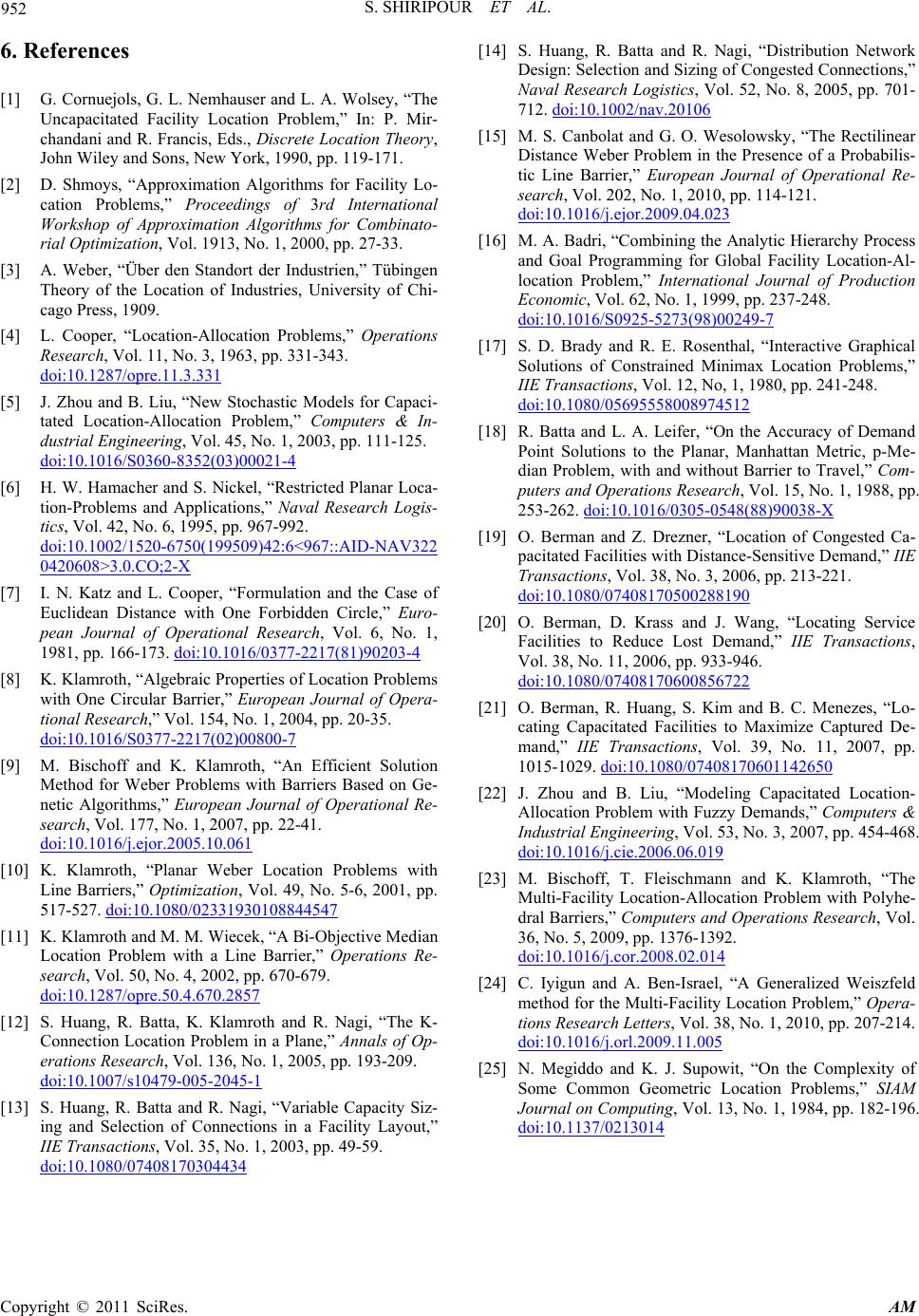
S. SHIRIPOUR ET AL.
Copyright © 2011 SciRes. AM
952
6. References
[1] G. Cornuejols, G. L. Nemhauser and L. A. Wolsey, “The
Uncapacitated Facility Location Problem,” In: P. Mir-
chandani and R. Francis, Eds., Discrete Location Theory,
John Wiley and Sons, New York, 1990, pp. 119-171.
[2] D. Shmoys, “Approximation Algorithms for Facility Lo-
cation Problems,” Proceedings of 3rd International
Workshop of Approximation Algorithms for Combinato-
rial Optimization, Vol. 1913, No. 1, 2000, pp. 27-33.
[3] A. Weber, “Über den Standort der Industrien,” Tübingen
Theory of the Location of Industries, University of Chi-
cago Press, 1909.
[4] L. Cooper, “Location-Allocation Problems,” Operations
Research, Vol. 11, No. 3, 1963, pp. 331-343.
doi:10.1287/opre.11.3.331
[5] J. Zhou and B. Liu, “New Stochastic Models for Capaci-
tated Location-Allocation Problem,” Computers & In-
dustrial Engineering, Vol. 45, No. 1, 2003, pp. 111-125.
doi:10.1016/S0360-8352(03)00021-4
[6] H. W. Hamacher and S. Nickel, “Restricted Planar Loca-
tion-Problems and Applications,” Naval Research Logis-
tics, Vol. 42, No. 6, 1995, pp. 967-992.
doi:10.1002/1520-6750(199509)42:6<967::AID-NAV322
0420608>3.0.CO;2-X
[7] I. N. Katz and L. Cooper, “Formulation and the Case of
Euclidean Distance with One Forbidden Circle,” Euro-
pean Journal of Operational Research, Vol. 6, No. 1,
1981, pp. 166-173. doi:10.1016/0377-2217(81)90203-4
[8] K. Klamroth, “Algebraic Properties of Location Problems
with One Circular Barrier,” European Journal of Opera-
tional Research,” Vol. 154, No. 1, 2004, pp. 20-35.
doi:10.1016/S0377-2217(02)00800-7
[9] M. Bischoff and K. Klamroth, “An Efficient Solution
Method for Weber Problems with Barriers Based on Ge-
netic Algorithms,” European Journal of Operational Re-
search, Vol. 177, No. 1, 2007, pp. 22-41.
doi:10.1016/j.ejor.2005.10.061
[10] K. Klamroth, “Planar Weber Location Problems with
Line Barriers,” Optimization, Vol. 49, No. 5-6, 2001, pp.
517-527. doi:10.1080/02331930108844547
[11] K. Klamroth and M. M. Wiecek, “A Bi-Objective Median
Location Problem with a Line Barrier,” Operations Re-
search, Vol. 50, No. 4, 2002, pp. 670-679.
doi:10.1287/opre.50.4.670.2857
[12] S. Huang, R. Batta, K. Klamroth and R. Nagi, “The K-
Connection Location Problem in a Plane,” Annals of Op-
erations Research, Vol. 136, No. 1, 2005, pp. 193-209.
doi:10.1007/s10479-005-2045-1
[13] S. Huang, R. Batta and R. Nagi, “Variable Capacity Siz-
ing and Selection of Connections in a Facility Layout,”
IIE Transactions, Vol. 35, No. 1, 2003, pp. 49-59.
doi:10.1080/07408170304434
[14] S. Huang, R. Batta and R. Nagi, “Distribution Network
Design: Selection and Sizing of Congested Connections,”
Naval Research Logistics, Vol. 52, No. 8, 2005, pp. 701-
712. doi:10.1002/nav.20106
[15] M. S. Canbolat and G. O. Wesolowsky, “The Rectilinear
Distance Weber Problem in the Presence of a Probabilis-
tic Line Barrier,” European Journal of Operational Re-
search, Vol. 202, No. 1, 2010, pp. 114-121.
doi:10.1016/j.ejor.2009.04.023
[16] M. A. Badri, “Combining the Analytic Hierarchy Process
and Goal Programming for Global Facility Location-Al-
location Problem,” International Journal of Production
Economic, Vol. 62, No. 1, 1999, pp. 237-248.
doi:10.1016/S0925-5273(98)00249-7
[17] S. D. Brady and R. E. Rosenthal, “Interactive Graphical
Solutions of Constrained Minimax Location Problems,”
IIE Transactions, Vol. 12, No, 1, 1980, pp. 241-248.
doi:10.1080/05695558008974512
[18] R. Batta and L. A. Leifer, “On the Accuracy of Demand
Point Solutions to the Planar, Manhattan Metric, p-Me-
dian Problem, with and without Barrier to Travel,” Com-
puters and Operations Research, Vol. 15, No. 1, 1988, pp.
253-262. doi:10.1016/0305-0548(88)90038-X
[19] O. Berman and Z. Drezner, “Location of Congested Ca-
pacitated Facilities with Distance-Sensitive Demand,” IIE
Transactions, Vol. 38, No. 3, 2006, pp. 213-221.
doi:10.1080/07408170500288190
[20] O. Berman, D. Krass and J. Wang, “Locating Service
Facilities to Reduce Lost Demand,” IIE Transactions,
Vol. 38, No. 11, 2006, pp. 933-946.
doi:10.1080/07408170600856722
[21] O. Berman, R. Huang, S. Kim and B. C. Menezes, “Lo-
cating Capacitated Facilities to Maximize Captured De-
mand,” IIE Transactions, Vol. 39, No. 11, 2007, pp.
1015-1029. doi:10.1080/07408170601142650
[22] J. Zhou and B. Liu, “Modeling Capacitated Location-
Allocation Problem with Fuzzy Demands,” Computers &
Industrial Engineering, Vol. 53, No. 3, 2007, pp. 454-468.
doi:10.1016/j.cie.2006.06.019
[23] M. Bischoff, T. Fleischmann and K. Klamroth, “The
Multi-Facility Location-Allocation Problem with Polyhe-
dral Barriers,” Computers and Operations Research, Vol.
36, No. 5, 2009, pp. 1376-1392.
doi:10.1016/j.cor.2008.02.014
[24] C. Iyigun and A. Ben-Israel, “A Generalized Weiszfeld
method for the Multi-Facility Location Problem,” Opera-
tions Research Letters, Vol. 38, No. 1, 2010, pp. 207-214.
doi:10.1016/j.orl.2009.11.005
[25] N. Megiddo and K. J. Supowit, “On the Complexity of
Some Common Geometric Location Problems,” SIAM
Journal on Computing, Vol. 13, No. 1, 1984, pp. 182-196.
doi:10.1137/0213014